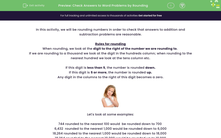In this activity, we will be rounding numbers in order to check that answers to addition and subtraction problems are reasonable.
Rules for rounding
When rounding, we look at the digit to the right of the number we are rounding to.
If we are rounding to a thousand we look at the digit in the hundreds column; when rounding to the nearest hundred we look at the tens column etc.
If this digit is less than 5, the number is rounded down.
If this digit is 5 or more, the number is rounded up.
Any digit in the columns to the right of this digit becomes a zero.

Let's look at some examples:
744 rounded to the nearest 100 would be rounded down to 700
6,432 rounded to the nearest 1,000 would be rounded down to 6,000
18,264 rounded to the nearest 1,000 would be rounded down to 18,000
18,264 rounded to the nearest 10,000 would be rounded up to 19,000
Now let's use rounding to check that the answer to a word problem is reasonable.
Car A travels 16,562 miles in a year.
Car B travels 18,215 miles in the same year.
How far do they travel in total?
First, calculate the answer: 16,562 + 18,215 = 34,777 miles
Now, let's round the numbers to the nearest 1,000 and then add them to see if the answer is reasonable.
17,000 + 18,000 = 35,000
Looking at the estimate, we can assume that 34,777 is probably the correct answer.
If the answer was very different we could assume that we had made an error!

Now why don't you have a go at some questions like these?







